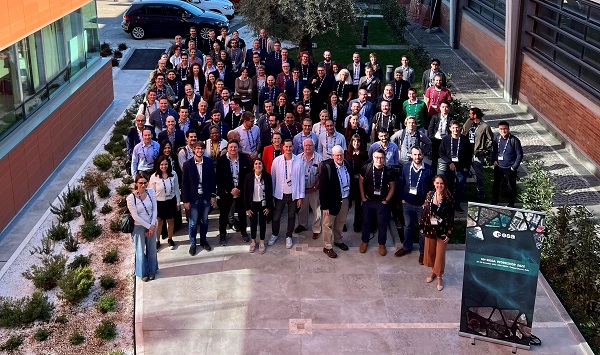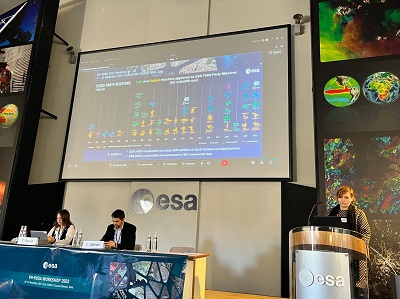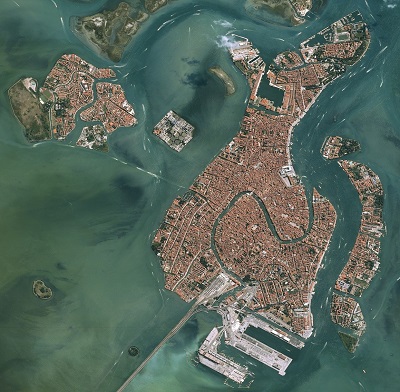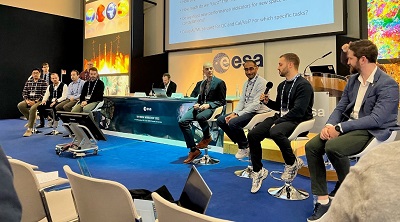- News
- ESA ensures quality of very hi...
ESA ensures quality of very high resolution data from New Space providers
09 Nov 2022

ESA is taking steps to verify the accuracy of the growing amounts of very high resolution data delivered by commercial missions, as set out in a workshop held this week in ESRIN.
The forum – called VH-RODA – was attended by experts in the domain of data quality, calibration and validation, to allow dialogue across commercial and public stakeholders.
The VH-RODA (Very High-resolution Radar & Optical Data Assessment) workshop took place this week at ESA/ESRIN, in Frascati (Italy), from 7–10 November.
While ESA strongly supports new space involvement and is expanding its relations with very high resolution (VHR) contributors - new space data can only be used if we can trust their accuracy. Therefore, discussions and presentations at the workshop centred around efforts to put in place best practices for data quality, so that private and public sectors can work in coordination with each other.
As ESA prepares for the upcoming Ministerial Council meeting later in November, it is apparent that high resolution and VHR Earth observation (EO) data are central to ESA’s ambitions to advance space programmes.

The workshop was therefore timely, aiming to identify crucial issues that arise as more and more VHR providers enter the arena. Discussions raised the need to develop synergy with non-VHR missions, facilitate interoperability and ensure harmonisation in calibration and validation (Cal/Val) approaches, even on an international level.
Attendance at the workshop was strong, spanning 38 countries, with over 190 in person participants and close to 300 overall including online attendees.
A range of presentations aired the challenges of data quality, calibration and product validation in remote sensing satellites – but with a focus on the impact of new space on the arena.
For more than four decades, ESA’s Earthnet programme has provided the framework to access EO data from non-ESA missions, via ESA’s Third Party mission (TPM) programme.

Peggy Fischer, mission manager for ESA’s Third Party mission (TPM) programme, made a presentation on how the TPM programme supports European New Space by facilitating free access to commercial data for research and scientific purposes.
“Users can exploit the synergy between all sources of data for new applications by combining TPM data with ESA mission data,” says Fischer.
The results speak for themselves: since 2008, more than 12,000 research projects used TPM data and this year alone, the programme registered over 2000 new science users.
The TPM programme also allows ESA to act as an anchor for VHR EO data, while maintaining quality control.
“Earth observation data from commercial and new space missions are quality benchmarked by ESA and industrial expert teams, prior to TPM distribution,” adds Fischer.
The Earthnet Data Assessment Project (EDAP+) aims to assess the quality and suitability of candidate non-ESA remote sensing missions under consideration for ESA’s Third Party Mission programme. Similarly, other national programmes provide processes to bring onboard commercial data vendors.

In USA, NASA’s Commercial SmallSat Data Acquisition (CSDA) programme establishes a continuous and repeatable process to bring onboard commercial data vendors for dissemination alongside NASA EO data.
A presentation by CSDA showed how these commercial data are preserved for long-term use in the same way as for NASA data and shortly may be accessed via their portal.
Ensuring harmonisation in calibration and validation approaches was another theme of the workshop. CSDA aims to have data quality criteria based on the draft joint ESA-NASA Evaluation Framework Guidelines for SAR and Optical data.
Ensuring the long-term confidence in the accuracy and quality of Earth observation data and products is the mission of the WGCV (Working group for Cal/Val). A presentation by the group’s activities iterated the need to build trust in data from new space.
The WGCV acknowledges that small satellites in general cannot guarantee the same quality as institutional satellites, so best practice comparison plays a big role in new space.
The group identified a demand for well-defined calibration targets, which drove the development of a new network of calibration facilities for multifrequency SAR.

The working group provides a number of tools and facilities that support Cal/Val and information from the group is shared via their portal.
They also support interoperability, even in an international context. Enhancing interoperability between satellites and products will only extend their use in various global applications, such as agriculture, forestry, vegetation and pollution monitoring.
Essential to using data from new sources is having a good understanding of their characteristics, how they are calibrated and their quality and technical capabilities.
The VH-RODA workshop makes it apparent, that as data from commercial and institutional satellites are utilised by worldwide users, this should be done in a complementary and synergetic manner with careful coordination on Cal/Val and data quality activities.